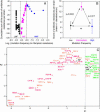Intermediate mutation frequencies favor evolution of multidrug resistance in Escherichia coli
- PMID: 15965238
- PMCID: PMC1456789
- DOI: 10.1534/genetics.105.045526
Intermediate mutation frequencies favor evolution of multidrug resistance in Escherichia coli
Abstract
In studying the interplay between mutation frequencies and antibiotic resistance among Escherichia coli natural isolates, we observed that modest modifications of mutation frequency may significantly influence the evolution of antibiotic resistance. The strains having intermediate mutation frequencies have significantly more antibiotic resistances than strains having low and high mutation frequencies.
Figures

References
-
- Bignami, M., I. Casorelli and P. Karran, 2003. Mismatch repair and response to DNA-damaging antitumour therapies. Eur. J. Cancer 39: 2142–2149. - PubMed
-
- Blazquez, J., 2003. Hypermutation as a factor contributing to the acquisition of antimicrobial resistance. Clin. Infect. Dis. 37: 1201–1209. - PubMed
-
- Branch, P., D. C. Bicknell, A. Rowan, W. F. Bodmer and P. Karran, 1995. Immune surveillance in colorectal carcinoma. Nat. Genet. 9: 231–232. - PubMed
-
- Cooper, V. S., and R. E. Lenski, 2000. The population genetics of ecological specialization in evolving Escherichia coli populations. Nature 407: 736–739. - PubMed
Publication types
MeSH terms
Substances
LinkOut - more resources
Full Text Sources

